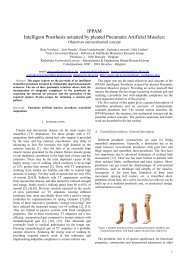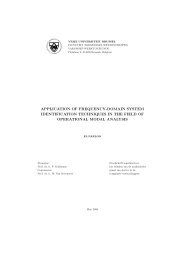64 CHAPTER 4. SOUND ABSORPTIONabsorbing materials is close to that <strong>of</strong> air. Seen that this impedance is ra<strong>the</strong>rsmall (∼ 400 rayl), it is not easy to find solid materials which absorb enoughsound. However, <strong>the</strong>re exist alternative solutions for <strong>the</strong> physical realization<strong>of</strong> sound absorption, based on o<strong>the</strong>r phenomena :A plate on a layer <strong>of</strong> airHelmholtz resonatorPorous acoustic absorbing materialsFollowing sections will give an overview <strong>of</strong> <strong>the</strong>se three methods.4.2 Realization <strong>of</strong> acoustic absorption4.2.1 Plate on an air layerA plate on an air layer belongs to <strong>the</strong> category <strong>of</strong> resonant absorption means.Onefixes aplate (plywood, chipboard, sheet metal, hardboard, plasterboard,etc.), using wooden slats or pr<strong>of</strong>ile irons, at a distance <strong>of</strong> some centimetersin front <strong>of</strong> a hard wall (see Figure 4.4). The plate, toge<strong>the</strong>r with <strong>the</strong> airbehind it, constitutes a mass-spring system. The plate represents <strong>the</strong> mass,while <strong>the</strong> air represents <strong>the</strong> spring element. In fact <strong>the</strong> plate has also someresilience, but it can be shown that its influence is negligible once <strong>the</strong> plate is<strong>of</strong> a certain size (starting from 1 m x 1m). The method <strong>of</strong> attachment <strong>of</strong> <strong>the</strong>plate is <strong>the</strong>refore almost <strong>of</strong> no importance, i.e. one may reason on a highlysimple physical model: a plate freely suspended on an air cushion <strong>of</strong> a fewcm thickness. The wave length <strong>of</strong> sound is supposed to be much bigger than<strong>the</strong> thickness <strong>of</strong> <strong>the</strong> air cushion, so no wave phenomena occur. Let :m mass per square meter <strong>of</strong> panel surface,d damping per m 2 ,k <strong>the</strong> stiffness coefficient <strong>of</strong> <strong>the</strong> air layer behind <strong>the</strong> plate,p <strong>the</strong> excitation force per m 2 , i.e. <strong>the</strong> sound pressure incident on <strong>the</strong> plate.<strong>the</strong>n one can find for this model with one degree <strong>of</strong> freedom :mẍ+dẋ+kx = p (4.11)or by writing <strong>the</strong> equation in function <strong>of</strong> <strong>the</strong> particle velocity v :∫m˙v +dv +k vdt = p (4.12)
4.2. REALIZATION OF ACOUSTIC ABSORPTION 65For harmonic signals : ˙v = iωv and ∫ vdt = 1 v and thus Equation 4.12 caniωbe rewritten :iωmv +dv +k viω = p (4.13)Thus, <strong>the</strong> impedance z = p <strong>of</strong> <strong>the</strong> system is given by :vz = iωm+d+ k(4.14)iωOne can show that <strong>the</strong> stiffness k <strong>of</strong> <strong>the</strong> air layer is given by k = γP 0D(no pro<strong>of</strong> is given in this text), with P 0 <strong>the</strong> atmospheric pressure and D <strong>the</strong>distance between plate and wall. The resonance frequency <strong>of</strong> <strong>the</strong> mass-springsystem can be deduced from Equation 4.13 :f 0 = 1√k2π m = 1√γP0(4.15)2π mDIn <strong>the</strong> practical case <strong>of</strong> a light panel, for example, this gives, with m =4kg/m 2 and D = 0.04 m, f 0 = 150 Hz. Now when a sound wave hits<strong>the</strong> panel, it will vibrate at <strong>the</strong> frequency <strong>of</strong> <strong>the</strong> sound. When this forcedfrequency is in <strong>the</strong> vicinity <strong>of</strong> <strong>the</strong> eigenfrequency <strong>of</strong> <strong>the</strong> panel, calculatedabove, shall this strongly vibrate on <strong>the</strong> air spring. All sorts <strong>of</strong> friction losseswill <strong>the</strong>n occur (internal losses in <strong>the</strong> panel due to <strong>the</strong> deformation, friction<strong>of</strong> <strong>the</strong> panel on <strong>the</strong> slats, etc...) which cause <strong>the</strong> loss <strong>of</strong> vibrational energy,i.e. sound energy will be absorbed. Moreover when rockwool or glass woolmats are applied in <strong>the</strong> air gap, than this will augment <strong>the</strong> dissipation <strong>of</strong>energy, making <strong>the</strong> sound absorption increased in a wider domain around<strong>the</strong> eigenfrequency <strong>of</strong> <strong>the</strong> panel. I.e. <strong>the</strong> damping term d can be consciouslyadapted to <strong>the</strong> needs. When <strong>the</strong> expression <strong>of</strong> <strong>the</strong> impedance is put into<strong>the</strong> expression <strong>of</strong> <strong>the</strong> absorption, one is capable to calculate <strong>the</strong> acousticabsorption coefficient <strong>of</strong> a given material as a function <strong>of</strong> frequency. Theexperimentally obtainedvalue<strong>of</strong>aisusuallysmaller, andtypically nothigherthan0.5 (generally 0.3 to 0.4) and<strong>the</strong> bandwidth amounts to several octaves.The eigenfrequency is low, thus a panel on an air layer is typically applied toabsorb low tones. Absorption at low frequencies is <strong>of</strong>ten absent in modernbuildings, one canencounter absorption <strong>of</strong> highfrequencies in <strong>the</strong>se buildingsdue to, for example, porous fiber board, which is applied as lost mold <strong>of</strong> <strong>the</strong>ceilings.4.2.2 Helmholtz resonatorBy applying a large number <strong>of</strong> holes (round, elongated, ... ) to a panel, itsacoustic properties are changed. When a sound wave impinges on a perforatedpanel, <strong>the</strong> incident sound wave will not vibrate <strong>the</strong> mass <strong>of</strong> <strong>the</strong> panel
















